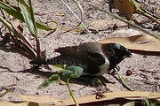
Bronze Mannikin
Encyclopedia
The Bronze Mannikin or Bronze Munia Lonchura cucullata is a small passerine
(i.e. perching) bird
. This estrildid finch
is an abundant resident breeding bird in much of Africa
south of the Sahara Desert of dry savanna habitats. It has an estimated global extent of occurrence of 8,100,000 km².
The nest is a large domed grass structure in a tree, into which 4-8 white eggs are laid. This species also builds communal roosting nests, used overnight and dismantled and rebuilt daily.
The Bronze Mannikin is 9–10 cm in length with a long black tail. The adult has a stubby grey bill, brown upperparts, a dark purple head and white underparts with dark flank markings. There is an iridescent green shoulder patch.
The sexes are similar, but immatures are plain brown above with buff head and underparts. This species has a number of calls including a rreep-rreeep in flight and a twittering when perched.
Passerine
A passerine is a bird of the order Passeriformes, which includes more than half of all bird species. Sometimes known as perching birds or, less accurately, as songbirds, the passerines form one of the most diverse terrestrial vertebrate orders: with over 5,000 identified species, it has roughly...
(i.e. perching) bird
Bird
Birds are feathered, winged, bipedal, endothermic , egg-laying, vertebrate animals. Around 10,000 living species and 188 families makes them the most speciose class of tetrapod vertebrates. They inhabit ecosystems across the globe, from the Arctic to the Antarctic. Extant birds range in size from...
. This estrildid finch
Estrildid finch
The estrildid finches are small passerine birds of the Old World tropics and Australasia. They can be classified as the family Estrildidae , or as a sub-group within the family Passeridae, which also includes the true sparrows....
is an abundant resident breeding bird in much of Africa
Africa
Africa is the world's second largest and second most populous continent, after Asia. At about 30.2 million km² including adjacent islands, it covers 6% of the Earth's total surface area and 20.4% of the total land area...
south of the Sahara Desert of dry savanna habitats. It has an estimated global extent of occurrence of 8,100,000 km².
Characteristics
The Bronze Mannikin is a tiny gregarious bird which feeds mainly on seeds. It frequents open country and cultivation, especially near water.The nest is a large domed grass structure in a tree, into which 4-8 white eggs are laid. This species also builds communal roosting nests, used overnight and dismantled and rebuilt daily.
The Bronze Mannikin is 9–10 cm in length with a long black tail. The adult has a stubby grey bill, brown upperparts, a dark purple head and white underparts with dark flank markings. There is an iridescent green shoulder patch.
The sexes are similar, but immatures are plain brown above with buff head and underparts. This species has a number of calls including a rreep-rreeep in flight and a twittering when perched.

